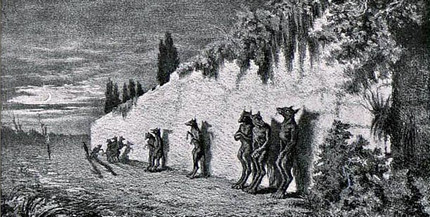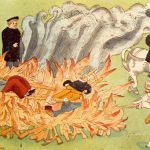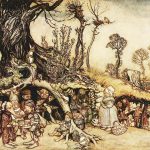Ergot poisoning has been proposed to explain werewolf episodes in Europe in the 18th and 19th centuries as both a cause of an individual believing that he or she is a werewolf and of a whole town believing that they had seen a werewolf.

Ergotism was known by a variety of names:
- St. Anthony’s Fire, and – to the physicians of seventeenth-century England – ‘suffocation of the mother’.
- The fungus ergot is sometimes known as Wolf or Wolfszahn (‘Wolf-tooth’).
Symptoms
Among the symptoms of this virulent, and often lethal, condition are: disruption of motor control functions, causing tremors and writhing, wry neck, convulsions, rolling eyes, and speechlessness; dizziness, confusion, hallucinations, panic attacks, and delusions; extreme thirst, uncontrollable appetite; feelings of extreme heat, or even cold, with itching and tingling, swelling and blistering of the skin.
Theory
During the period from 1520 to 1630 there were over 30,000 werewolf trials in France alone. Most of the people who were tried as being werewolves were poor, and came from lowlands with elevations less than 500 feet above sea level.
Rye bread was a staple for the poorer people of France, and after cold winters the rye developed the Ergot fungus, a widespread parasite of cereal grains. Dr. Mary Matossian, professor of history at the University of Maryland, derived a theory that the peasants were eating a rye bread that was contaminated by a fungus that acted as a powerful hallucinogenic.
In essence, Dr. Matossian suggested that thousands of men and women were suffering from "bad trips" from a potent fungus that caused them to have delusions that they were magical beings capable of transforming themselves into werewolves.
History
The earliest reference to ergotism in the Annales Xantenses for the year 857: "a Great plague of swollen blisters consumed the people by a loathsome rot, so that their limbs were loosened and fell off before death."
In the Middle Ages, the gangrenous poisoning was known as ignis sacer ("holy fire") or "Saint Anthony’s fire", named after monks of the Order of St. Anthony who were particularly successful at treating this ailment.
The 12th century chronicler Geoffroy du Breuil of Vigeois recorded the mysterious outbreaks in the Limousin region of France, where the gangrenous form of ergotism was associated with the local Saint Martial as much as Saint Anthony.
The blight, named from the cock’s spur it forms on grasses, was identified and named by Denis Dodart, who reported the relation between ergotized rye and bread poisoning in a letter to the French Royal Academy of Sciences in 1676 (John Ray mentioned ergot for the first time in English the next year), but "ergotism", in this modern sense, was first recorded in 1853.
Notable epidemics of ergotism occurred up into the 19th century.
There was a significant outbreak of ergot-poisoning in France in the French village Pont-Saint-Esprit in 1951. The incident is described in John Grant Fuller’s book The Day of St Anthony’s Fire.
The French victims reported ‘being chased or attacked by horrible beasts’, ‘terror of the dark’, and ‘feeling that my body was not mine’ together with tingling/burning sensations in the extremities and the scalp.
Another man with ergot poisoning reportedly escaped from seven straight jackets, lost all his teeth biting through a leather strap, and bent two iron bars on the hospital window while trying to flee from a tiger he believed to be chasing him.
Fewer outbreaks have occurred since then due to rye being carefully monitored in developed countries.
Process
Rye grass is by far the most widespread species parasitized, though wheat and barley are also commonly affected. The ‘ergots’ appear as a blackish-purple club, shaped growth on the tops of the rye where the seeds are, and are referred to as "heads of ergot".
From these heads sprout the Claviceps purpurea fungal fruiting bodies which has long stems with bulbous heads when seen under a strong glass or microscope. T
he growth of ergot is stimulated by certain atmospheric conditions: it grows best in overcast and damp weather. Epidemics have been linked to volcanic eruptions, particularly in Scandinavia; and the presence of nearby marshland or lakes is enough to moisten the air sufficiently to facilitate the growth of ergot.
Analysis
Ergot naturally produces a wide range of chemical compounds, the ones of relevance here are collectively known as the "Ergot Alkaloids", and include ergotamine, ergosine and beta-ergosine, ergonine, ergovaline, ergostine, ergotine and beta-ergotine, ergocornine, ergocristine, ergocryptine and beta-ergocryptine.
These compounds all have some degree of psychoactivity. Lysergic Acid Diethylmide (LSD) was first synthesized from ergot compounds. The psychoactive components of ergot are not broken down by heat, so it is fair to assume that they would be present in bread baked from flour milled and ergotized grains.
But Ergot Fungi is essentially poisonous before being hallucinogenic and the transformation into LSD is a complex chemistry procedure that cannot occurs naturally.
Moreover, legends of animal transformations, as well as hysteria and superstition in general, have existed across the world for all of recorded history.
Even if ergot poisoning is found to be an accurate explanation in some cases, it cannot be applied to all instances.








